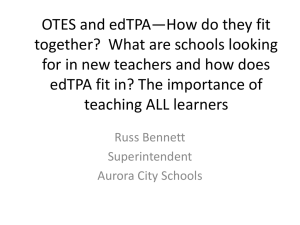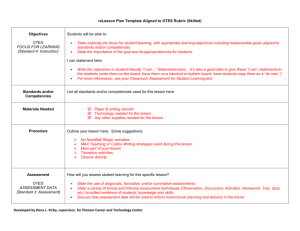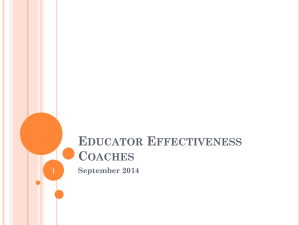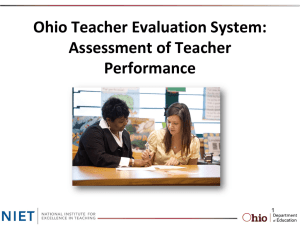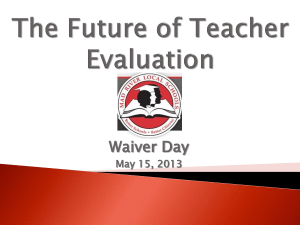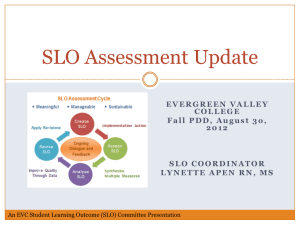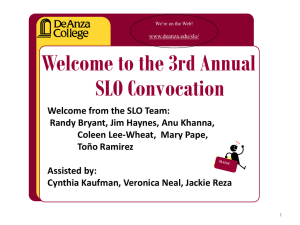MedEastOhioOTESAMode..
advertisement
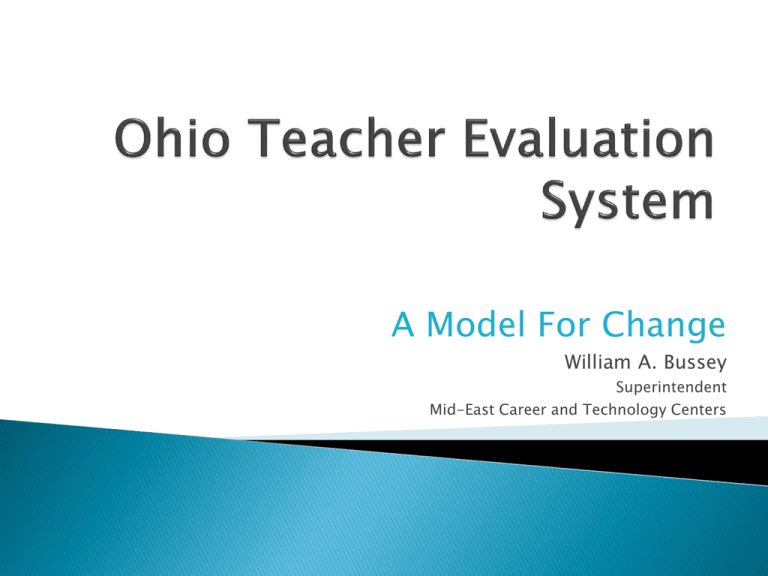
A Model For Change William A. Bussey Superintendent Mid-East Career and Technology Centers Implementing OTES through the Ohio Appalachian Collaborative (OAC) and Teacher Incentive Funds(TIF) All teachers will be evaluated using the OTES Model-Teacher Performance Standards All administrators are credentialed evaluators All teachers will develop and monitor one Student Learning Objective Review the processes, results, and challenges with both the performance rating and student growth measures Reflect on the good, the bad, and the ugly Review any changes as we transition to the "authentic" evaluation tool for teachers this coming school year I have brought with me the experts! ◦ ◦ ◦ ◦ Barb Funk Dan Coffman Scott Sabino Michelle Patrick OTES Team created in the Spring of 2012 ◦ ◦ ◦ ◦ ◦ Executive Director Building Directors New Asst. Director-role is evaluation Asst. Director - role Curriculum and OAC/TIF Teachers Introduced the OTES framework to all leadership teams District Transformation Team Strategic Compensation Team OTES Team Formative Instructional Practices Team Assessment/Literacy Tech Team HSTW Site Coordinators Train key people within the district Success starts with a solid foundation Teacher led PD would increase staff buy-in ◦ Ensure teachers understood: Framework of the new evaluation system New components New tools New process Process would increase teacher/admin collaboration time Initial OTES Staff training ◦ Teacher Performance – OTES Model 7 Teaching Standards Placed in the performance rubric Teacher Evidence Calibration of a standard to a teaching video Completed self-assessment ◦ Student Growth – Student Learning Objectives o November PD • Mini Sessions on Formative Instructional Practices, Literacy w/CC Anchor Standards in Reading and Writing, BFK and Value Added, Teacher Evidence o February PD • State training manual on Student Growth Measures o Quarterly Meetings used as check points o Conversations with evaluator Pre-Pre Observation Conference Self-Assessment Tool (Optional in the process, but discovered to be a MUST DO!) Professional Growth Plan (See example) ◦ Met with teachers (last two week of October) to review the process timeline and elements (paperwork and documentation) and answer questions. ◦ Follow-up to In-service Day. ◦ Teacher Performance Goal (Goal 2)- Influenced by Self-Assessment Tool and Ohio Teaching Standards ◦ Self-directed ◦ Statement of the goal and how it will be measured ◦ Student Achievement Goal (Goal 1)- Influenced by SLO (Use standard from pre-assessment used to develop SLO) ◦ Specific standard and how it will be measured Teacher Performance Evaluation Rubric (TPER)- (See example) ◦ Evaluation begins with Proficient (“Rock solid teaching”) ◦ Video examples- see NIET Training Modules ◦ Examine key words and phrases embedded in rubric at each level (Proficient, Accomplished and Developing) Pre-Conference ◦ Teachers complete/submit responses using ohiotpes.com ◦ Face-to-face Observation ◦ 30 minutes ◦ Script the lesson! Post-Conference Classroom Walkthroughs (2-5 per teacher) ◦ ◦ ◦ ◦ ◦ ◦ ◦ ◦ Follows each observation Specific questions relating to the lesson and the instructor Relate to TPER Area for Reinforcement/Refinement Shared with the teacher Opportunity for feedback Used paper form and ohiotpes.com The more often, the better! Set schedule early and put it on the teachers. It’s the teachers’ evaluation and their responsibility to provide evidence/documentation relating to the TPER. Round 1 Pre-Conference Observation Walkthrough(s) Post-Conference Round 2 Pre-Conference Observation Walkthrough(s) Post-Conference Summative Performance Rating Conference Use measures of student growth effectively in a high quality evaluation system Make informed decisions on the right measures Make informed decisions about the appropriate weight of measures Increase reliability and validity of selected measures Teachers completed the development, implementation and scoring process SLO timeline with specific due dates, calendar with expectations Teachers created their SLO and chose their growth target Implemented the SLO Calculated the results Three main types of targets used ◦ Whole group ◦ Tiered/grouped targets ◦ Individual Targets Whole group target-one target for all students in SLO ◦ All students will score a 75% or better on the post assessment Tiered/grouped target-range of targets for groups of students ◦ Pre-assessment scores between 0 – 25 would be expected to score between 25-50 on post assessment Individual target-each student in the SLO receives a target score ◦ Using a formula such as (100 – pretest)/2 + the pretest = growth target Teacher Name: Formula Method School: Mid East CTC - Zanesville Campus SLO: Assessment Name: Student Name 1 2 3 4 5 6 7 8 9 10 11 Baseline Growth Target Final Score Met Target 28 64 80 Yes 20 60 48 No 44 72 76 Yes 28 64 76 Yes 12 56 48 74 84 Yes 20 60 44 No 28 64 52 No 40 70 88 Yes 32 66 84 Yes 28 64 60 No 6 of the 10 students met/exceed their growth target 60% Descriptive Rating Most Effective Above Average Average Approaching Average Least Effective Percentage Exceed/Met Numerical Tiered Formula Whole Group Rating 90-100% 5 10% 20% 10% 80-89% 4 30% 20% 36% 70-79% 3 20% 0 9% 60-69% 2 20% 6% 9% 59 or below 1 20% 54% 36% Teacher Performance Ineffective Rating Above 5 Developing Rating Accomplished Accomplished Proficient Developing Expected 2, 3, 4 Proficient Rating Proficient Proficient Developing Developing Below 1 Student Growth Accomplished Rating Developing Developing Ineffective Ineffective Fall 2011 469 students were tested 81% (379) students earned a bronze or better Intervention Provided through KeyTrain Online Spring 2012 90 students were tested 71% (64) students earned a bronze or better 40% 50% 5% 5% Bronze Silver Gold Not yet 2011-2012 Level I 27% 64% 7% 2% 2012-2013 Bronze Silver Gold Not yet Level II 14 Programs Bronze 11 Programs Silver 70% Met or Exceeded Occupational Profile! 1 Program Gold Fall 2012 467 students were tested 86% students earned a bronze or better Intervention Provided through KeyTrain Online Spring 2013 60 students were tested 55% students earned a bronze or better 37% 54% 4% 5% Bronze Silver Gold Not yet 2012-2013 Level I 2013-2014 Level II Content Area 2012-2013 2011-2012 2010 -2011 English 151 150 146 Math 143 143.25 141.75 Science 147.5 145 143.50 Zanesville Campus College Readiness Benchmark 156 2013 149 2012 145.2 2011 142.5 Chemistry 157 147 144.9 144 Algebra I 152 142 142.1 142.9 Geometry 152 144 142.9 140.3 Algebra II 149 143 144.5 142.4 PreCalculus 145 143 144.5 141.2 English 10 147 151 147.8 144.8 English 11 152 149 150.2 147.3 Physics 150 US History 150 English 9 154 English 12 153 Subject Biology Buffalo Campus Subject Biology College Readiness Benchmark 156 2013 147 2012 145.4 2011 144.2 145.4 143.5 Chemistry 157 Algebra I 152 141 142.6 142.4 Geometry 152 144 143.2 141.6 Algebra II 149 144 143.9 142.8 PreCalculus 145 English 10 147 154 150.9 144.4 English 11 152 151 151.9 146.3 Physics 150 US History 150 English 9 154 English 12 153 Teacher Category Value Added Vendor Assessments LEA Measures Total SLO/Other Shared Attribution A (Value Added) B (vendor Assessments C (LEA Measures) 30% 10% 10% 10% 50% 30% 10% 50% 40% 10% 50% Data Analysis and Assessment Literacy Data Analysis and Setting Growth Targets ◦ Data driven decisions – What data? ◦ Engage in transparent conversations around student growth Outliers, class size, averages, ranges Identify trends, patterns, expectations for mastery Gather other available data Zoom-in and identify similarities and differences in students Build staff Assessment Literacy Priority Standards Appropriate assessments Quality Assessment Design Assessment Blue Print reflects instruction Instructional Tasks move students to meet standards Conversations and Collaboration Greater focus on Student Learning Deeper reflection of the: ◦ teaching and learning process ◦ accountability of growth for all students ◦ role student growth plays in determining Educator Effectiveness Policy developed utilizing the template provided by ODE ◦ Simple to allow for flexibility ◦ Change as we negotiate our contract Further development by the district SLO Evaluation Committee for SLO guidelines • • What made us breathe a sigh of relief when it was over What went well/positive elements • • Yes, some things were quite positive! Suggestions/ways to use our internal feedback and insight to feed forward Roller Coaster of Emotions WHEW that took some time! ◦ 5 hours per teacher per observation? *gulp* ◦ What do I give up? ◦ Walkthroughs? Technology ◦ eTPES downfalls Other evaluations? Walkthrough data? ◦ Support for all levels of learners Roller Coaster of Emotions Process was overall positive ◦ From Self-Assessments Reflection ◦ Consensus: “It’s not so bad”!! Technology based Trial year! WOOHOOO Focused purpose and common dialogue Collaboration ◦ Holistic ◦ Rubric ◦ Criteria not a checklist ◦ ◦ ◦ ◦ ◦ Administrator with associate school principals Administrators with administrator Administrators with teachers Teachers with teachers Utopia! Self-Assessment – everyone Walkthrough data – form that collects data we need? ◦ Experimenting with Google Forms? ◦ Use to see trends Non-instructional staff evaluations ◦ OSCES, ASCA, and OTES ◦ Input from staff Opportunities for more alignment ◦ for professionals to align all goals; IPDP, OTES/OPES, Resident Educator, ◦ to look for trends and align with PD, ◦ to group professionals with aligned goals as they work together to improve their practice, ◦ to align ourselves as evaluators - do we truly calibrate? Can we better align (with each other) by discussing our ratings and why, etc., etc., etc.
